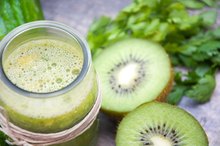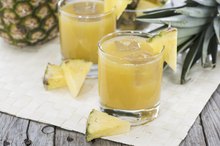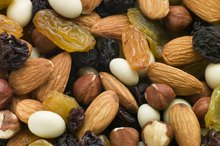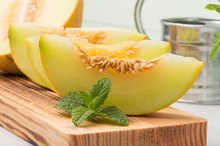Fiber Content of Blueberries
With the sustained emphasis on eating a healthy diet, fruits such as blueberries, blackberries, strawberries, raspberries and other seeded berries are readily recognized for their nutritional benefits. When eaten with their seeds and skins intact, blueberries are great source of dietary fiber. Fiber, a special form of complex carbohydrate, travels relatively intact through your digestive tract and promotes normal bowel movements.
Recommended Intake
The Institute of Medicine advises women to eat a minimum of 30 grams of fiber a day until age 50 and then 21 grams daily after that 2. Men need at least 38 grams of fiber daily through age 50, when the requirement drops to 30 grams. Your child’s diet should incorporate at least 10 grams of fiber daily plus an additional gram for every year of age. A 3-year old needs a minimum of 13 grams, for example, but a 10 year old requires at least 20 grams for good health.
- The Institute of Medicine advises women to eat a minimum of 30 grams of fiber a day until age 50 and then 21 grams daily after that 2.
Fiber Content
Fiber in Kiwifruit
Learn More
If you eat a 1-cup serving of fresh blueberries, you’ll add 3.6 grams of fiber to your daily intake, along with 84 calories and 21.5 grams of carbohydrate. The same portion of frozen unsweetened blueberries delivers 4.2 grams of fiber and 18.9 grams of carbohydrates in 79 calories. Blueberry juice typically has 5 grams of fiber in a 1-cup serving, along with 19 grams of carbohydrates and 80 calories.
- If you eat a 1-cup serving of fresh blueberries, you’ll add 3.6 grams of fiber to your daily intake, along with 84 calories and 21.5 grams of carbohydrate.
- Blueberry juice typically has 5 grams of fiber in a 1-cup serving, along with 19 grams of carbohydrates and 80 calories.
Benefits
Blueberries offer a fiber-rich, low-calorie snack or menu item relatively low in carbohydrates, particularly if you select fresh or frozen berries rather than fruit canned in sugar syrup. When you eat or drink a blueberry product, the fiber from the fruit makes you feel full sooner and stay full longer than low-fiber processed foods. This effect helps you achieve or maintain a healthy body weight. Fiber also slows the absorption of nutrients from your intestines, providing a steady blood glucose levels that’s beneficial to people with diabetes.
- Blueberries offer a fiber-rich, low-calorie snack or menu item relatively low in carbohydrates, particularly if you select fresh or frozen berries rather than fruit canned in sugar syrup.
- Fiber also slows the absorption of nutrients from your intestines, providing a steady blood glucose levels that’s beneficial to people with diabetes.
Considerations
List of Roughage Foods
Learn More
If you’re on a high-fiber diet for your overall health, or if your doctor has advised you to increase your dietary fiber to control a chronic disease like constipation or diverticulosis, blueberries are a great menu option. Although fruit juices are usually much lower in fiber than their raw counterparts, blueberry juice is an exception to that rule. You can enjoy fresh, frozen or juiced blueberries as one part of your high-fiber diet. If your doctor recommends a low-fiber diet for certain disease phases or before medical procedures, stay away from blueberries in any form.
- If you’re on a high-fiber diet for your overall health, or if your doctor has advised you to increase your dietary fiber to control a chronic disease like constipation or diverticulosis, blueberries are a great menu option.
- If your doctor recommends a low-fiber diet for certain disease phases or before medical procedures, stay away from blueberries in any form.
Related Articles
References
- Continuum Health Partners: Bowel Function & Fiber
- U.S. Department of Agriculture: National Nutrient Database: Blueberries
- Full article: Changes in dietary fiber intake in mice reveal associations between colonic mucin O-glycosylation and specific gut bacteria
- Fiber
- Fiber
- Closing America’s Fiber Intake Gap
- Meta-Analysis of Usefulness of Psyllium Fiber as Adjuvant Antilipid Therapy to Enhance Cholesterol Lowering Efficacy of Statins - ScienceDirect
- Fiber
- Fiber
- New Horizons for the Study of Dietary Fiber and Health: A Review | SpringerLink
- FoodData Central
- Error
- FoodData Central
- Error
- None
- FoodData Central
- Error
- None
- FoodData Central
- Acute Effects of Nitrate-Rich Beetroot Juice on Blood Pressure, Hemostasis and Vascular Inflammation Markers in Healthy Older Adults: A Randomized, Placebo-Controlled Crossover Study - PubMed
- FoodData Central
- None
- FoodData Central
- None
- FoodData Central
- FoodData Central
- FoodData Central
- FoodData Central
- None
- FoodData Central
- Error
- Error
- FoodData Central
- Error
- FoodData Central
- FoodData Central
- Effect of Oat β-Glucan Intake on Glycaemic Control and Insulin Sensitivity of Diabetic Patients: A Meta-Analysis of Randomized Controlled Trials - PubMed
- Error
- FoodData Central
- FoodData Central
- FoodData Central
- None
- FoodData Central
- FoodData Central
- None
- None
- FoodData Central
- None
Resources
Writer Bio
Sandy Keefe, M.S.N., R.N., has been a freelance writer for over five years. Her articles have appeared in numerous health-related magazines, including "Advance for Nurses" and "Advance for Long-Term Care Management." She has written short stories in anthologies such as "A Cup of Comfort for Parents of Children with Special Needs."









